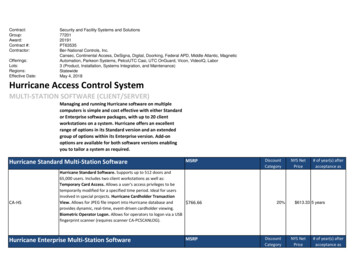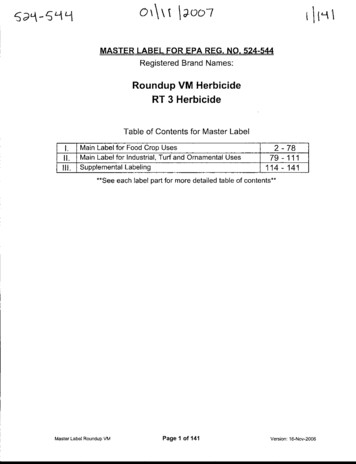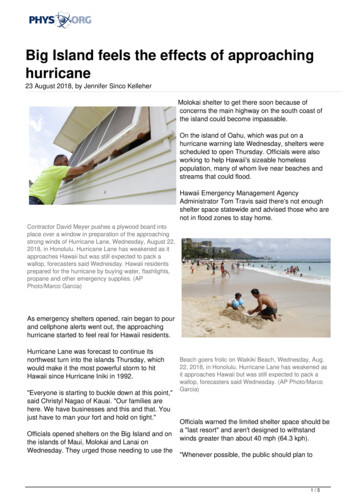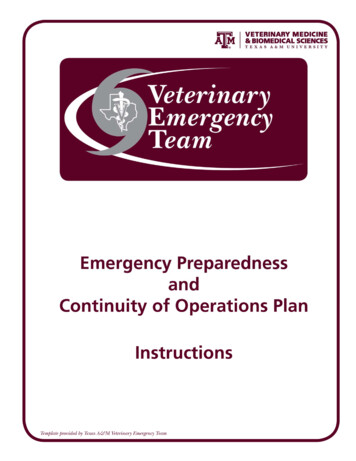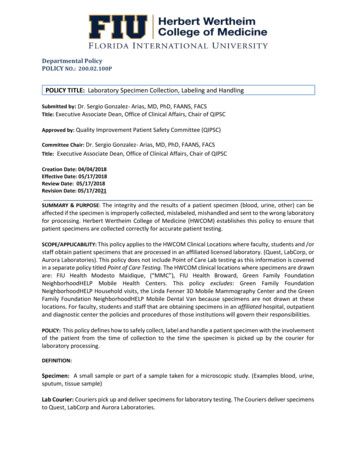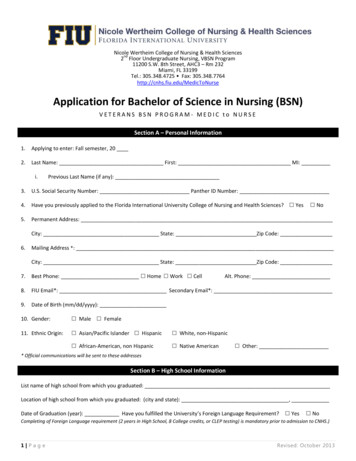
Transcription
Hurricane-ReadyCookbookHealth Promotion ServicesFlorida International UniversityStudent Health Center 18011200 SW 8th StreetMiami, FL 331991
Table of ContentsIntroduction.3My Plate.4Hurricane Preparation Tips: Before, During and After.5Hurricane Shopping List.7Common Measurements.8Recipe IndexBreakfast.9Simple Cereal and Milk with Fruit.10Chia Pudding Two Ways.10Chocolate Chia Pudding with Bananas and Nuts.10Simple Chia Pudding.11Oatmeal.11Basic Oatmeal.11The Elvis.11Apple, Raisin and Walnut Oatmeal.12Tropical Fruit Oatmeal .12Healthy Muesli.12Snacks.13DIY Oatmeal Bars or Balls.14Apples and Peanut Butter with Granola.14Savory Ants on a Log.14Hummus.15No-Bake Layered Bean Dip.15Easy Trail Mixes.16Cereal Trail Mix.16Nuts and Fruit Trail Mix.16Sandwiches.17Healthy Tuna Salad Sandwich.18Curried Chicken Salad Sandwich.18Eggless Egg Salad.19Banana Crunch Wrap.19Salads.20Italian Three Bean Salad with Potatoes.21Tuna-Stuffed Tomato.21Sweet Three Bean Salad.21Sardine Greek Salad.22Southwest Bean Salad.22Main Dishes.23Lentil Tacos.24Sesame Tofu, Carrot and Pea Dish.24Bean Burrito.25White Bean Burrito.25Canned Salmon and New Potato with Herbs.26Hurried Curry.26Mashed Sweet Potatoes with Vegetarian Baked Beans.27Beans and Rice with Veggies.27IntroductionDuring a hurricane, eating healthy may be one of the last things on your mind.However, feeding yourself and your family properly is important during disasterconditions. Our Hurricane Cookbook makes it easy for you to make healthy choicesduring stressful situations.All of these recipes can be made without power and can be prepared easily bythose with basic cooking skills. They are balanced meals that contain fruits andvegetables, healthy fats, complex carbs and lean proteins. The recipes contain amix of canned and fresh foods.History of the Hurricane CookbookThe Hurricane Cookbook was first developed in 2006 by students from the FIUDietetics and Nutrition Program under the supervision of Dr. Marcia Magnus.The book itself was put together by the Department of Dietetics and Nutrition incoordination with Student Health Services, and edited by Dr. Marcia Magnus andMariela Gabaroni, MS. In 2015, this cookbook was updated by Health PromotionServices Dietitian, Christine Tellez, MS, RD.How to Use the CookbookWe recommend that you use our grocery list to get the needed supplies 1-2months before the beginning of hurricane season. Also, prepare some of therecipes on a regular weeknight to find your recipes and change them to your liking.We hope you enjoy the cookbook and use it as part of your hurricanepreparedness plan.Good health to all!Christine Tellez, MS, Registered DietitianFIU Health Promotion ServicesAcknowledgmentsAlexandra Santori Karen Gonzalez Dr. Marcia Magnus Mariela Gabaroni, MSPhoto CreditsShutterstock.comPictures are for illustrative purposes only.These and many other practical brochures are available fromyour local American Red Cross:American Red Cross:Miami-Dade (305) 644-1200Broward (954) 797 -3800Palm Beach (561) 833- 7711On the Internet, useful information about Disaster Survival Kits and Preparing Your Home forDisaster can be found mily.\For more information about these recipes, contact Christine Tellez at(305) 348-4020 or email wellness@fiu.edu
MyPlate:Healthy Eating Made SimpleHurricane Preparation Tips:Before, During, and AfterMyPlate makes eating healthy easier by givingus a visual guide as to what our plate shouldlook like. My Plate encourages the publicto remember to include a variety of fruits,vegetables, whole grains, lean proteins anddairy on their plates every day.Follow the tips below to get your plate in shape!For more individualized nutrition help, make anappointment with our Registered Dietitian.Before Hurricane Season Look in your pantry and check expiration dates. Throwaway expired foods and use foods that will expire soon. Stock your pantry. Use the Hurricane Cookbook shoppinglist or your own to get non-perishable necessities.Separate them from other pantry goods. Buy enough food and water for 3 days per person inyour household. Buy 1 gallon per day, per person. Somepeople may need more water per day. Always keep fresh fruits and vegetables on hand.Make half of your plate fruits and vegetables.Eat a variety of vegetables, especially dark-green, red and orange varieties. Addfresh, dried, frozen or canned fruits to meals and snacks.Make at least half your grains wholeChoose 100% whole-grain breads, cereals, crackers, pasta and brown rice. Checkthe ingredients list on food packages to find whole-grain foods. Explore new grainslike quinoa, barley, amaranth in addition to rice. Starchy vegetables like potatoes,sweet potatoes, yucca, plantains, and corn can take the place of grains.Switch to low-fat milk and dairy products.Low-fat milk has the same amount of calcium and other essential nutrients aswhole milk, but less fat and calories. For those who are lactose intolerant, trylactose-free milk or calcium-fortified non-dairy beverages. If you don’t like milk, tryyogurt or kefir to get calcium and Vitamin D throughout the day. During hurricaneconditions, choose non-perishable dairy and non-dairy milks.Vary your protein choices.Eat a variety of foods from the protein food group each week, such as seafood,poultry, nuts and beans, and eggs. Keep meat and poultry portions small andlean. Be sure to choose seafood at least twice a week to get the benefits of hearthealthy omega-3 fats.Cut back on sodium and empty calories from solid fats andadded sugars.Compare sodium in foods and choose those with lower numbers. Try seasoningyour foods with herbs and spices instead of salt. When eating canned foods, drainand rinse prior to eating to get rid of some of the sodium. Switch from solid fats tohealthy oils like olive and canola oil. Replace sugary drinks with water and choosefruit for dessert more often.4Under Hurricane Warning Stock up on whole fresh fruit and vegetables, likeapples,bananas, pears, potatoes, tomatoes, andcucumbers. Whole fruit will stay good longer. Make sure your pantry and water supplies are stocked. Prep some meals beforehand, boil some eggs, cook pasta,rice, quinoa, or make some potatoes or sweet potatoes. Wash all fruits and vegetables, tops of canned foods, andcooking utensils to avoid having to wash if the power goesout or if there is no safe water. Set refrigerator and freezer to the highest setting. Fill freezer and refrigerator with food to keep cold.If the Power Goes Out Keep the refrigerator and freezer doors closed as much aspossible. A refrigerator will keep food cold for about 4 hours ifkept closed. A full freezer will keep temperature for 48 hours or24 hours if half full. If the power is going to be out for an extended period of time,buy dry or block ice to keep the refrigerator as cold as possible.Fifty pounds of dry ice should keep a fully-stocked 18-cubic-feetfreezer cold for two days. Wash fruits and vegetables with water from a safe source. For infants, try to use prepared, canned baby formula that doesnot require adding water. For concentrated or powdered formula,prepare with bottled rather than tap water.5
When the Power is Restored Check refrigerator and freezer thermometers. If thefreezer reads 40 F or below, the food is safe andmay be refrozen. If you did not use a thermometer in the freezer,check each package. If the food still contains icecrystals, it is safe to refreeze or cook.Food Safety During a Hurricane Uneaten portions must be thrown awayif not consumed after 2 hours and reacha temperature of 40 F. Never eat any food that does not looknormal. Remember,“When in doubt, throwit out!” Do not consume suspicious foods,regardless of the expiration date. Do not eat foods from cans that areswollen, dented, or corroded, even thoughthe product may look safe to eat. Fruits, vegetables, and breads spoil andgrow mold faster without refrigeration. Lookfor signs of spoilage and discard items ifnecessary. Keep food in covered containers. Keep garbage in closed containers anddispose outside, burying garbage ifnecessary.Hurricane Shopping GuideStock a two-week supply of non-perishable foods throughout hurricane season.Below is a shopping list to help guide you:Fruits and VegetablesDried FruitTomatoes-diced, sauceNo sugar added applesauce100% Juice containersFresh vegetables-greens, tomatoes, avocado,onions, peppers, cucumbers, etc.Fresh whole fruit-apples, bananas, pears,orangesCanned vegetables with no salt added-corn,carrots, mixed vegetables, beets, etc.Canned soups-low sodiumSweet potatoes, potatoes, cornVegetable juiceProteinsCanned beans-black, pinto, chickpeasCanned meats-salmon, chicken, tuna,sardinesPeanut butterChia and flax seedsUnsalted nuts-almonds, peanuts, cashewsTofu, Mori-Nu or other nonperishablebrandNon-perishable milk of choiceLaughing Cow CheeseCarbohydrates/GrainsBrown or Wild riceWhole wheat pastaOatmealCerealWhole Wheat tortillas, wraps, pitaWhole grain crackersBreadMuesliCooking Oils and SeasoningOlive and canola oilButter spray or non-stick sprayVinegarsMustardDried herbs and spicesSalt and pepperSoy sauceSalad dressingSnacks* The CDC recommends packing such items as dairy products, meats,eggs, and spoilable leftovers in a cooler or chest filled with ice. A foodthermometer should be included in your hurricane supplies — it canbe used to test foods requiring refrigeration. If such foods reach atemperature of more than 40 degrees Fahrenheit for more than two hours,they should not be eaten. er.asp6Trail mixGranola and protein barsRice cakesPudding cupsTortilla chips, crackersPumpkin and sunflower seedsTools and OthersDisposable cutlery, plates, cupsHand sanitizer and wipesNon-electric can openerNapkinsMixing bowlPlastic containersMixing utensils / knivesWaterGarbage bagsCamp stove
Common Measurementsand AbbreviationsTeaspoon/Tsp (t)Tablespoon /Tbsp (T)Gallon (gal)Liter (l)BreakfastBreakfast is the most important meal of the day.Start your day off right with these healthyoptions that will keep you satisfied until lunch!Ounce (oz)Fluid Ounce (fl oz)Pound (lb)Gram (g)8Cup (c)Pint (pt)Quart (qt)
Simple Cereal and Milk with Fruit(Serves 1)Cereal can be an easy and tasty way to start your day.Follow our guidelines to choose the right one.Ingredients1-1 ½ cup cereal (see guidelines)1 cup of shelf stable milk of choice1 cup of fruitDirectionsCombine cereal and milk. Top with fruit of choiceor
In 2015, this cookbook was updated by Health Promotion Services Dietitian, Christine Tellez, MS, RD. How to Use the Cookbook We recommend that you use our grocery list to get the needed supplies 1-2 months before the beginning of hurricane season. Also, prepare some of the recipes on a regular weeknight to find your recipes and change them to your liking. We hope you enjoy the cookbook and

